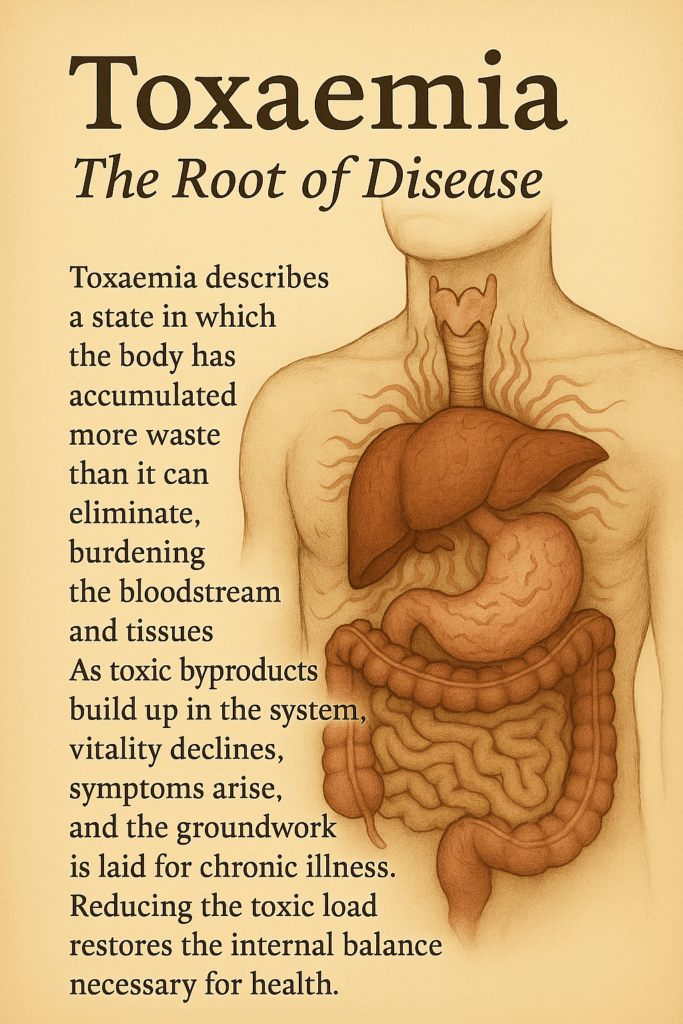Toxaemia is one of the most important concepts in Natural Hygiene and underpins the entire understanding of how the body becomes unwell. It describes a state in which the bloodstream and tissues carry more waste, metabolic debris and foreign material than the body can comfortably process and eliminate. When the internal terrain becomes burdened with accumulated waste, the vitality of the body drops, healing slows and symptoms begin to appear. Rather than seeing disease as something that attacks from outside, Natural Hygiene views toxaemia as the internal condition that allows illness to develop.
At its core, toxaemia means that the body has taken on more waste than it can clear. This waste can come from metabolic processes, poor digestion, environmental toxins, chemical exposure, overeating, stimulants, low-grade chronic stress and suppressed emotions. In a healthy and balanced state, the body continually removes these by-products through the lungs, kidneys, skin, intestines and lymphatic system. When the load becomes too high, waste begins to accumulate in the tissues faster than it can be removed.
Toxaemia lies at the foundation of many acute and chronic conditions. When the body senses an overload of internal waste, it triggers biological emergency programmes to restore balance. These appear as fevers, mucus discharge, skin eruptions, diarrhoea, coughing, inflammation, fatigue and many symptoms that are commonly labelled as illnesses. In truth, these responses are not the disease but the body’s intelligent attempt to remove excess toxic matter.
Acute symptoms, such as colds or flu-like episodes, are often detoxification events where the body mobilises waste and expels it through the quickest available channels. The fever increases metabolic speed, the mucus traps and escorts waste out of the system and the appetite drops to conserve energy for cleansing. This is why eating lightly or fasting during illness often speeds recovery. When the body does not need to digest heavy food, it can use all available vitality to clear the internal terrain.
Chronic disease is often the long-term result of unresolved toxaemia. When toxins accumulate over years or decades, the body adjusts by creating adaptations. These include inflammation, hardened tissues, growths, cysts, stones, thickened blood and eventually degenerative conditions. None of these occur randomly. The body creates these changes to protect itself from a backlog of waste that it has been unable to remove through normal channels.
The liver and lymphatic system play central roles in managing toxaemia. The liver neutralises and processes waste, while the lymphatic system carries metabolic by-products away from the cells. When the liver is overburdened with processed foods, stimulants, drugs, alcohol, pesticides or chronic digestive disturbance, it cannot keep up with detoxification demands. The lymph becomes thick and stagnant, digestion becomes sluggish and the blood carries a higher toxic load.
Stress is another major contributor to toxaemia. Emotional and mental stress produce biochemical waste products that must be cleared. When stress becomes chronic, the body remains in sympathetic dominance, reducing digestion, slowing elimination and increasing inflammation. Poor sleep and artificial light intensify this internal burden. Without restorative rest, the body struggles to clear the waste created during daily living.
Diet is one of the most powerful factors affecting toxaemia. Heavy, processed and cooked foods break down slowly and incompletely, leaving behind metabolic residue that accumulates over time. Animal foods, fried foods, oils, refined sugars and stimulants create a higher volume of waste than the body can efficiently process. In contrast, fresh fruits, leafy greens and water-rich foods contain their own enzymes and natural hydration, making them easy for the body to digest and leaving minimal residue. This is why people often feel lighter and clearer when they eat a natural diet.
Toxaemia also explains why fasting is such a powerful healing tool. When the digestive system rests completely, the body uses its energy to clear stored waste. The blood becomes cleaner, the lymphatic system begins to move, the liver can catch up on backlogged detoxification tasks and old toxic material is finally mobilised. Many people experience temporary symptoms during fasting because the body is releasing stored waste into circulation before removing it.
The human body has a remarkable ability to restore itself when given the right conditions. Reducing toxaemia by eating clean food, drinking pure water, sleeping early, breathing deeply, getting fresh air and reducing stress allows the internal terrain to return to balance. Once the toxic load decreases, symptoms diminish and vitality increases. Instead of suppressing symptoms, Natural Hygiene focuses on removing the underlying cause so the body can heal naturally.
Toxaemia is not a theory. It is a biological reality observed in every tissue of the body. When waste accumulates, disease follows. When waste is removed, health returns. This simple principle explains why healing requires cooperation with the body rather than interference. The body does not need complicated protocols or aggressive interventions. It needs cleanliness, rest and the removal of obstacles to healing.
Understanding toxaemia empowers people to take responsibility for their internal environment. By keeping the body clean through natural living, individuals can prevent many conditions associated with modern life. Instead of fighting illness, they can cultivate an internal state that does not allow illness to take root in the first place.


